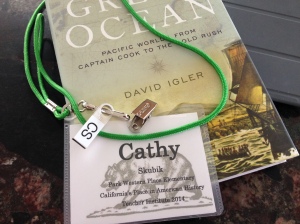
YEAH FOR ME! This past week found me sitting in a room at the Huntington Library and Gardens . Why celebrate that you ask? Easy! I have been participating in an institute teaching fourth and fifth grade teachers about how to access and use primary source documents in their classrooms. In addition, we are being slathered with generous history lectures from professors and graduate students (along with the books they have written) at UCIrvine, USC, UCRiverside and UCLA. I feel like a kid in a candy store. And I am getting paid. And fed. The only thing I do not celebrate is the commute. Traffic wipes me out and distracts me and stresses me.
However, it is worth it. I have learned a lot, and next week I return to start planning units and lessons with my colleagues. We will learn a little more too. I have already learned so much- and have had revolutionary discoveries and corrections of what I thought I knew about California history. I have seen some artifacts and documents that are pretty cool – in a nerdy history sort of way. Mostly, I have been struck by two things:
1) I have spent a ton of time developing my knowledge of how to teach reading and writing. My study and reading and professional development has been all about that. That is all good, and I am thankful yada yada yada… and of course I have more to learn. But it feels really good to be a learner about something else other than pedagogy and how-children-learn theories. It has felt REALLY good. It is interesting and fulfilling, but also important to stay in touch with how I learn, what it demands of me, and how I feel about the challenging parts. Just like writing helps me teach writing, reading helps me be a better teacher of reading, LEARNING helps me be better in touch with the demands I place on my students when I ask them to do that, sometimes all day long.
2) The second big aha has been about the parallel literacy skills required by primary source documents and the acts of reading and writing. Here are the big three for me, so far.
First, when you enter a primary source document for the first time, you are thrust into a world that is brand new to you. You don’t know much, and you have to be open to absorbing the new information coming your way as you read it closely – observing details and mining the document for clues about what is going on. Just like when you enter a chapter book or short story for the first time!
Second, as you begin to study a primary source, you develop a theory about what you are seeing and you form this theory based on evidence you have collected. Then as you study it more, and perhaps a teacher or historical source gives you additional information, you either confirm what you first thought or revise your theory about what you are seeing. Just like you revise and/or confirm your theories about characters in stories or ideas in informational texts!
And lastly, when you enter a document, you have to hold onto uncertainty. It is not clear what is going on at first, and it may never be entirely clear. The mystery is solved with evidence that makes things clear or evidence that opens up the need for interpretation. Either way, you have to be comfortable with uncertainty and holding on to theories, constantly weighing new information against what is known. Just like in a chapter book or short stories- where authors don’t always wrap things up with a neat bow, and frequently include mystery and detours to keep us discovering.
I celebrate my aha moment of seeing these parallel literacy skills, because I believe it will be another way to help reluctant readers practice these thinking skills in ways that may be more engaging and exciting than texts are to them at first. Then my work will be to help them transfer those skills to reading texts.








